The Black Pyramid Of Amenemhat III – Mysterious Underground Chambers And Lost Ancient Treasures
Ellen Lloyd - AncientPages.com - The Black Pyramid, constructed under the reign of Amenemhat III, was initially erected as a monumental edifice that bore witness to the Pharaoh's magnificent grandeur.
Unfortunately, the pyramid, originally named Amenemhet is Mighty, has been looted and lost all its treasures. The pyramid got its name for its dark, decaying appearance as a rubble mound, and when archaeologists started to excavate at the site, the Black Pyramid was already in ruins.
Only some people today are aware of its existence. Even if the Black Pyramid is not as famous as the Giza pyramids, it is a fascinating ancient structure providing some historical knowledge about ancient Egypt.
Ancient Secrets Of The Black Pyramid Of Amenemhat III
Amenemhat III, Pharaoh of the Twelfth Dynasty of Egypt, planned to be buried inside the Black Pyramid with his queen.
The "Black Pyramid" of King Amenemhat III. Credit: Tekisch - CC BY-SA 3.0
Still, there were construction problems, and he abandoned the building project. Instead, he built a new pyramid at Hawara, near the Faiyum. The Black Pyramid at Dahshur became the final resting place for some royal women. It is still unknown who is buried inside the Black Pyramid.
The "Black Pyramid" of King Amenemhat III. Credit: Tekisch - CC BY-SA 3.0
When excavation of the Dashur Pyramid started in 1892, archaeologists made many exciting discoveries. Many of the pyramid's stones had been stolen and used to build houses in the village and surrounding areas. However, some of the remaining stones found in the vicinity and inside the pyramid "were inscribed with boat scenes and the like, in a style which showed clearly that they had originally belonged to Old Kingdom Mastabas; and it was clear that Amenemhat in constructing his pyramid "had quarried extensively among earlier tombs, possible in Medum or Dashur." 1
The Black Pyramid was initially about 75 meters tall, with a base 105 meters long.
In front of the entrance to the pyramid, there was a colossal "false door! In red granite 3,86 meters high, inscribed with the names and titles of Amenemhat. This must have been the offering steal which Amenemhat originally intended should be set up in the temple in connection with the granite altar." 1
False doors were quite popular in ancient Egypt. According to ancient Egyptian beliefs, these enigmatic doors led to the underworld beyond.
In ancient Egypt, the "false doors" also known as "Ka doors" allowed the Ka (an element of the "soul") to pass through them, and these carvings were typical in the mortuary temples and tombs of ancient Egypt from around the Third Dynasty and temples of the New Kingdom.
Pyramidion (capstone) at Egyptian Museum, Cairo. Credit: Public Domain
As previously explained on AncientPages.com, "In Egyptian beliefs, the soul had three parts, the Ka, the Ba, and the Akh. These three spiritual elements found refuge in the body. Therefore, it was vital to keep the body intact after death and to equip it with the necessary items for life.
Ka survived the death of the body and could reside in an image or statue of a person. It was bound to the body and represented its vital (hyper-powerful physical forces). This Ka, which thus exists forever, so that 'to go to it' is synonymous with 'to die' (or 'to be resurrected), is created, like man himself." 2
When archaeologists entered the causeway which led to the chambers, they discovered "several deep tomb-shaft were opened, one of which produced a finely executed head of a statue of a XIIth dynasty king, probably Amenemhat III, and a stela dedicated to a prince named Hapu (XXth dynasty?) and another finely colored block relief, representing a vulture and hawk with outstretched wings." 1
The most exciting finds were made in the lower part of the Black Pyramid, where scientists came across a vast network of underground passages. In these underground chambers, they found sarcophagus and canopic jars.
Ancient Egyptians believed death was a transition to another reality, and the heart was always left inside the mummified corpse for use in the afterlife.
"Canopic jars were ritual vessels containing internal organs removed from the body of the deceased during the mummification process." 3
Archaeologists found a sarcophagus inside the King's chamber, which was still well-preserved but did not contain the mummy of the Pharaoh. The Queens' section was in bad condition and had been looted. In addition, archaeologists found four other burial chambers in the underground section of the Black Pyramid. Two of the burials are believed to belong to King Amenemhet IV and Queen Sobekneferu. The other two remain unidentified.
Pharaoh Amenemhat III. Credit: EditorfromMars - CC BY-SA 4.0
The Black Pyramid has countless corridors and chambers underground. What ancient treasures were once hidden inside will remain a mystery because this interesting ancient site has been plundered.
Was There Also A Black Pyramid At Giza?
There are not many black pyramids in Egypt, but there may once have been one at Giza.
"The existence of a fourth pyramid at Giza was documented by Danish explorer Frederic Louis Norden (1708-1742), who participated in an expedition to Egypt organized by the Frenchman Pierre Joseph le Roux d'Esneval on demand by the Danish King Christian VI.
Norden was not an amateur explorer. He was an experienced naval Captain, cartographer, and archaeological explorer who, before he visited Egypt in 1737, had traveled to countries like the Netherlands, France, Italy, and Malta to study fortifications.
When Captain Norden reached Egypt, he documented and drew everything he saw and experienced, including pharaonic monuments, architecture, installations, and maps. He made more than 200 drawings that can be found in his publication Voyage d'Egypte et de Nubie.
Some of his drawings made modern researchers puzzled. Why had Captain Norden drawn a fourth pyramid at Giza?
In his writings, Captain Norden stated: "There are four of them; they deserve the attention of the curious, even though they may be seven or eight in the neighborhood, they are nothing in comparison with the first (…) The two pyramids to the north are the biggest and have 500 feet perpendicular. The other two are much smaller but have some peculiarities that cause them to be examined and admired."
Captain Norden said the ancient structure's top was significant when describing the fourth pyramid. It seemed to be "a stone blacker than the granite common." 4
The existence of a black pyramid at Giza has never been confirmed, but we do know the Black Pyramid at Dahshur is real even though it has been looted.
Written by Ellen Lloyd – AncientPages.com
Updated on February 12, 2024
Copyright © AncientPages.com All rights reserved. This material may not be published, broadcast, rewritten or redistributed in whole or part without the express written permission of AncientPages.com
Expand for references- C. M. (1908). The Egyptian Expedition: III. The Pyramid of Amenemhat. The Metropolitan Museum of Art Bulletin,3(10), 184-188
- Sutherland - Why Were Ba And Ka Powerful Elements Of Soul In Ancient Egyptian Beliefs?, AncientPages.com
- Sutherland - Canopic Jars: Funerary Tradition Of Ancient Egyptians And Their Beliefs In Afterlife, AncientPages.com
- Ellen Lloyd - Ancient Mystery Of Egypt's Black Pyramid – Did It Really Exist? AncientPages.com
More From Ancient Pages
-
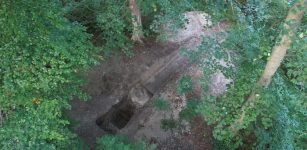 Mysterious Deserted Medieval Village And Castle Discovered In The Harz Mountains – 2,000 Artifacts Were Found
Archaeology | Nov 14, 2023
Mysterious Deserted Medieval Village And Castle Discovered In The Harz Mountains – 2,000 Artifacts Were Found
Archaeology | Nov 14, 2023 -
 Tiny Points Made By Homo Sapiens 54,000 Years Ago Found In Mandrin Cave
Archaeology | Feb 23, 2023
Tiny Points Made By Homo Sapiens 54,000 Years Ago Found In Mandrin Cave
Archaeology | Feb 23, 2023 -
 Okanagan Indians’ Myth Of A Lost Island Paradise Inhabited By White Giants – Are Their Descendants Living In British Columbia?
Featured Stories | Dec 29, 2020
Okanagan Indians’ Myth Of A Lost Island Paradise Inhabited By White Giants – Are Their Descendants Living In British Columbia?
Featured Stories | Dec 29, 2020 -
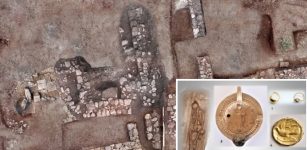 Ruins Of Long-Lost Ancient City Of Tenea Built By Trojans Discovered
Archaeology | Nov 21, 2018
Ruins Of Long-Lost Ancient City Of Tenea Built By Trojans Discovered
Archaeology | Nov 21, 2018 -
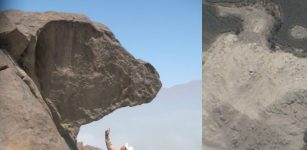 Rare Animal-Shaped Mounds Discovered In Peru
Archaeology | Apr 2, 2012
Rare Animal-Shaped Mounds Discovered In Peru
Archaeology | Apr 2, 2012 -
 World’s Oldest Fairy Tale – The Smith And The Devil Has Survived For Several Millennia
Ancient History Facts | Aug 30, 2017
World’s Oldest Fairy Tale – The Smith And The Devil Has Survived For Several Millennia
Ancient History Facts | Aug 30, 2017 -
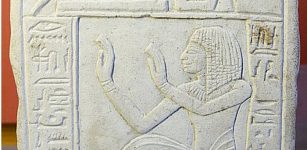 Meretseger: Theban Cobra Goddess Who Presided Over The Valley of The Kings
Egyptian Mythology | Jul 10, 2021
Meretseger: Theban Cobra Goddess Who Presided Over The Valley of The Kings
Egyptian Mythology | Jul 10, 2021 -
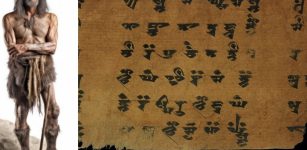 Ancient European Languages Shed Light On A Great Migration And Weather Vocabulary
Archaeology | Aug 14, 2023
Ancient European Languages Shed Light On A Great Migration And Weather Vocabulary
Archaeology | Aug 14, 2023 -
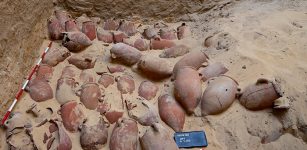 Largest Ancient Embalming Cachette Ever Found Unearthed At Abusir, Egypt
Archaeology | Feb 20, 2022
Largest Ancient Embalming Cachette Ever Found Unearthed At Abusir, Egypt
Archaeology | Feb 20, 2022 -
 Bizarre Ancient Capuchin Crypt ‘Decorated’ With The Bones Of 4,000 Monks
Ancient Traditions And Customs | Nov 22, 2018
Bizarre Ancient Capuchin Crypt ‘Decorated’ With The Bones Of 4,000 Monks
Ancient Traditions And Customs | Nov 22, 2018 -
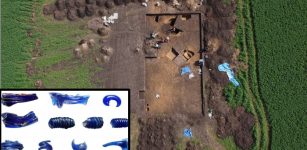 Ancient Glass Workshop Unearthed At Iron Age Of Němčice
Archaeology | Jul 24, 2023
Ancient Glass Workshop Unearthed At Iron Age Of Němčice
Archaeology | Jul 24, 2023 -
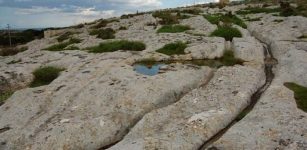 Unknown Highly Advanced Civilization Created Malta’s Cart Ruts With Sophisticated Machinery
Ancient Technology | Apr 26, 2014
Unknown Highly Advanced Civilization Created Malta’s Cart Ruts With Sophisticated Machinery
Ancient Technology | Apr 26, 2014 -
 Strange And Scary Encounter With Ancient Giants In North America
Featured Stories | Sep 23, 2021
Strange And Scary Encounter With Ancient Giants In North America
Featured Stories | Sep 23, 2021 -
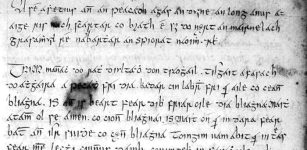 Is This The World’s Oldest Joke?
Featured Stories | Feb 21, 2014
Is This The World’s Oldest Joke?
Featured Stories | Feb 21, 2014 -
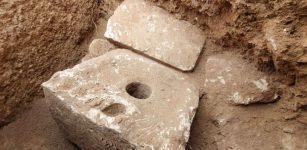 Stone Toilet Of A First Temple Period Luxury Villa Reveals The Jerusalem Elite Suffered From Infectious Disease
Archaeology | Jan 4, 2022
Stone Toilet Of A First Temple Period Luxury Villa Reveals The Jerusalem Elite Suffered From Infectious Disease
Archaeology | Jan 4, 2022 -
 Silver And Bronze Coins Discovered In Ancient Roman Fort Apsaros, Georgia
Archaeology | Jul 23, 2018
Silver And Bronze Coins Discovered In Ancient Roman Fort Apsaros, Georgia
Archaeology | Jul 23, 2018 -
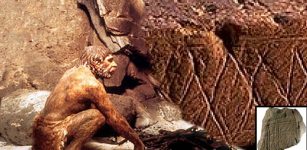 Is The Hashtag World’s Oldest Symbol And First Communication Attempt?
Ancient Symbols | Apr 27, 2018
Is The Hashtag World’s Oldest Symbol And First Communication Attempt?
Ancient Symbols | Apr 27, 2018 -
 Relics From Day-To-Day Life At Shakespeare’s Home – Now Shown In New Virtual Exhibition
Archaeology | Dec 11, 2020
Relics From Day-To-Day Life At Shakespeare’s Home – Now Shown In New Virtual Exhibition
Archaeology | Dec 11, 2020 -
 Askeladden – Little Trickster That Succeeds Where All Others Fail
Featured Stories | Mar 23, 2018
Askeladden – Little Trickster That Succeeds Where All Others Fail
Featured Stories | Mar 23, 2018 -
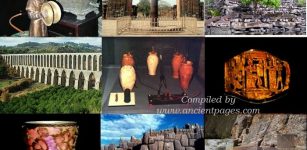 10 Remarkable Advanced Ancient Technologies Ahead Of Their Times
Ancient Technology | Jul 23, 2019
10 Remarkable Advanced Ancient Technologies Ahead Of Their Times
Ancient Technology | Jul 23, 2019




